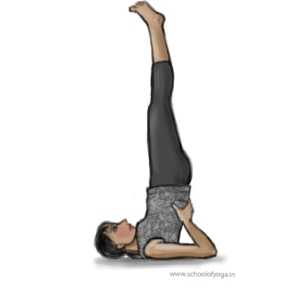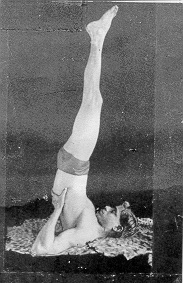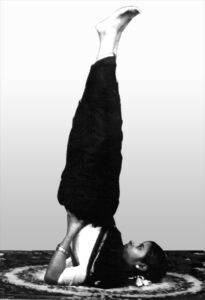Post By: Vishwanath Iyer Published on: December 15, 2016 Reading time: 5 minutes
In sarvangāsana, the practitioner balances the entire body on the shoulders, holding the head in a neck-lock with the chest. This sarvangāsana is an advanced āsana and must be learned under the supervision of a qualified expert.
 Sthithi (starting) position: On a soft mat, lie flat on the back.
Sthithi (starting) position: On a soft mat, lie flat on the back.
Seetharma Iyer performing sarvangāsana in 1960’s
This āsana bathes thyroid and para-thyroid, endocrine or ductless glands situated at the base of the neck on both sides of the windpipe with fresh oxygen rich blood. This is important because, thyroid controls the speed of chemical reactions in the body, influencing aspects such as rate of growth and development of sexual characteristics in adolescents. Also, a defective thyroid could lead to goitre and cretinism in children. Parathyroid also controls use of calcium and phosphorus in the body. Therefore, this āsana is very useful for rejuvenating all these related areas.

Yogacharya Sundaram demonstrating the perfect Sarvangasana (1920s)
If you have any form of back ache, do not attempt this āsana without adequate supervision and support.
Internal Links: Dharma (conditioning), Stress and Situational Awareness, Prana, Asana sequence, Asana schedule, Asana Focus or gazing, Pranayama, Hatha Yoga Pradeepika
External Links: Prana, Chakra, Pancha Tattva, Pancha Prana, Pancha Kosha, Nadi,

Smt. Sarada demonstrating sarvāsana in a saree (1950s)
Beginners should learn this āsana under supervision. The reason is that the entire body is upended to balance on the shoulder and back of the head. Therefore, any loss in balance could cause grievous damage to the neck, which should be avoided.